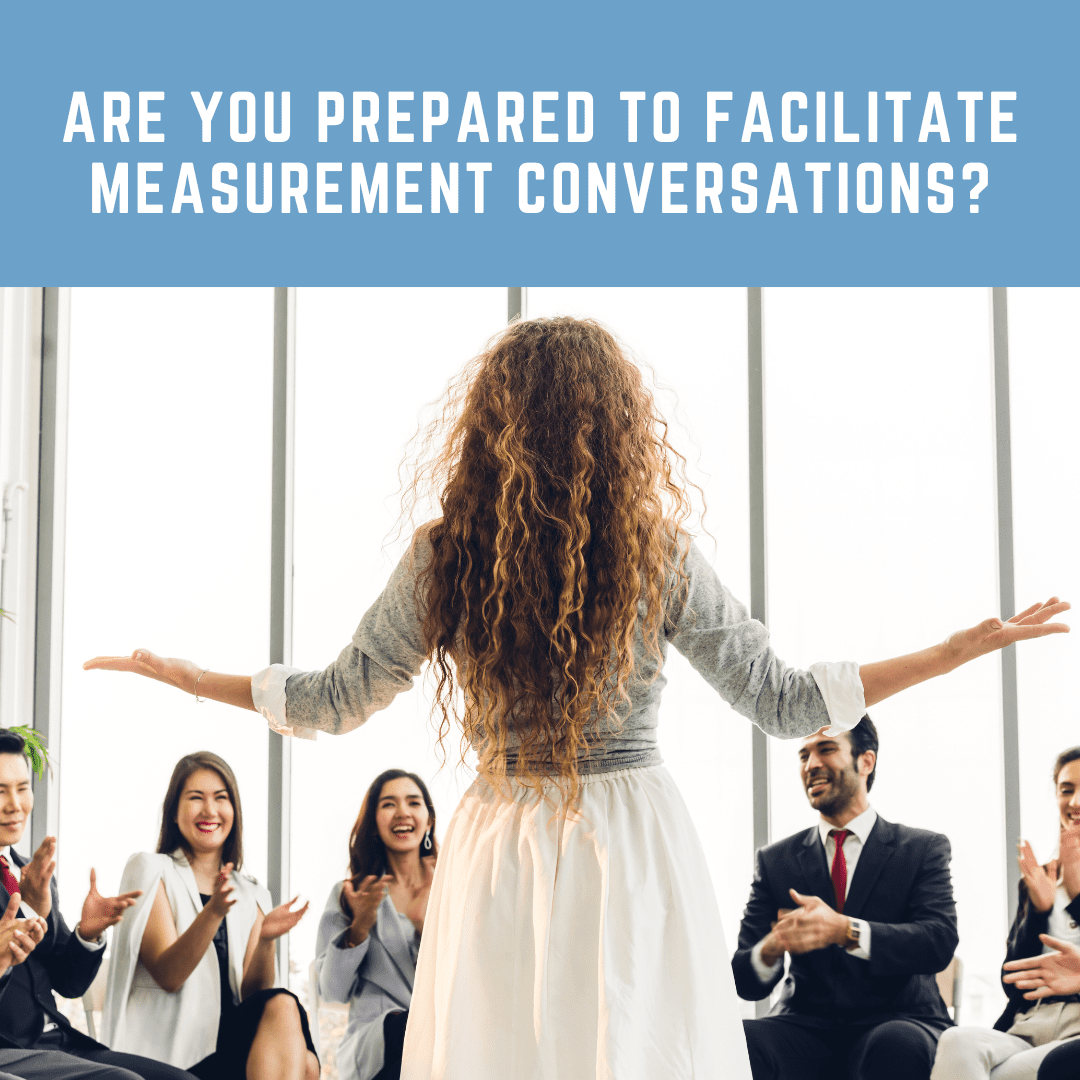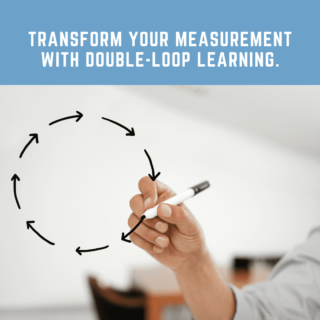Reflect on these 5 questions to help assess your readiness for leading measurement conversations.
Facilitating strategic conversations is a skill like any other. Meaning, it takes know-how, experience, patience and a learning mindset to improve. However, facilitating performance measurement conversations may even be one more skill level up. The facilitator needs a repeatable process that takes their team from a strategic goal in words, to developing meaningful quantified measures, including a way to visualize data, and ultimately to using insights to close the performance gap.
Often, though, we have no idea how to assess whether our current facilitation skillset will get us where we need to go with our organization’s measurement conversations.
So here are 5 questions (I call them “reflections”) for assessing your current facilitation skills. These five reflections and accompanying tips are simply for raising awareness and act as introductions to the concepts. If you want more, email me with your request.
Reflection #1: Do team members share the same understanding of what facilitation is?
Why is this important? We want to avoid any assumptions about what people think facilitation is and is not, and what facilitators are and are not.
Tip: If you answered no, or not sure, to this reflection question, share the following descriptions with your measures team and encourage a discussion.
What is facilitation? Facilitation is the art of leading people through guided processes towards desired outcomes with as much participation, creativity, and productivity as possible, to achieve results all team members understand, have appropriately contributed to, and accept. Facilitation is about bringing process and content together to achieve great task outcomes and great people interactions.
Note: having “Measurement Conversation Guides” will make the process more consistent and easier for everyone to build their skill around. If you (or someone in your organization) is trained in the PuMP process, these guides are available to you. If you are new to PuMP and don’t have the Step 2-3 guides, send us an email now.
What is a facilitator? A person who guides a group to achieve its goals by fostering effective communication, ensuring everyone can participate, and helping the group stay on track with its agenda. The person has skills and experience in creating a safe, inclusive environment for productive discussions, which helps the group make decisions, resolve conflicts, and accomplish tasks collaboratively. While a facilitator doesn’t typically take sides or provide the subject matter expertise themselves, they use strong interpersonal skills and knowledge of group dynamics to make the group’s process smoother and more efficient.
Reflection #2: How well am I encouraging self-management within the team?
Buy-in to performance measures for strategic goals only comes from involvement. When a facilitator encourages team members to take on specific roles during measurement conversations, the team’s self-management accelerates because:
- it keeps participants involved and alert as the team progresses through measurement conversations.
- it fosters learning, creates buy-in and increases ownership of measurement conversation outcomes.
- it helps the team be better prepared to make clear and timely decisions, set next steps, and take on responsibilities at meeting close.
Tip: Here are five suggestions for roles participants can take on to improve the team’s self-management:
- Team facilitator: as described earlier in this article.
- Meeting timekeeper: helps the team be aware of how they are progressing.
- Content recorder: while using the PuMP conversation guides, allows the team to see and check-in on the decisions they have made, and iterate as needed.
- Spokesperson: shares content with other stakeholders outside the team when feedback, buy-in, or approval is needed.
- Participant in the conversations: usually all team members (attendees) except for the facilitator, who stays neutral on content.
Reflection #3: Why is my own self-management important?
When we are facilitating strategic conversations, it is easy to focus on the behaviors of others; however, it is vital to remember that the only person we can control is ourself. And how we show up, can have considerable impact on those around us.
Emotions are contagious: How we manage our own emotions can impact the group’s emotions. If you feel frustrated, chances are your group will soon feel frustrated too. If you feel positive, it helps the group feel positive too.
Tip: Take a bit of time before your team’s measurement conversation to check-in with yourself, about how you are feeling. Ask yourself “how do I want to show up for the team in this meeting?”. If something significant is impacting you, it is ok to let the team know. Detail is not required, just awareness so the group develops an empathic mindset.
Triggers can derail conversations: Most of us have experienced a personal trigger when engaging in measurement conversations. It’s normal; but, what we want is to be able to increase the space between feeling triggered and our response.
Tip: If you want to improve how you respond in the moment when triggered, here is one process (there are likely many others).
- Pause
- Take a deep breath
- Pose your response as a question, to gain more perspective and distance. An example “Tell me more…”
- Listen actively to the response.
- It is also totally ok to request a break.
For a deeper understanding of our own triggers, try writing about your past experiences of feeling triggered during a measurement conversation in the workplace. Describe what was happening, your response, and what happened after your response. Over time, look for themes which may help you prepare for future interactions.
Reflection #4: How do we create safe space for measurement conversations in small groups?
As a facilitator, it is useful to be aware that many aspects of meeting planning, delivery, facilitation, as well as a participant’s past experiences, can impact how safe people feel in a group meeting.
Tip: For this article, we focus on the use of meeting norms during a facilitated meeting.
Why do we develop meeting norms?
- To establish explicit, visible and agreed-upon guidelines for behavior, which clarifies expectations, promotes cooperation, and reduces misunderstandings.
- Norms create a predictable and respectful environment, leading to more focused and productive discussions, efficient decision-making, and a stronger sense of unity within the team. By agreeing on these “how-to-work-together” guidelines, teams can more effectively collaborate, even when tackling difficult topics.
- But just having meeting norms is pointless unless team members are clear on how to individually use them during the meeting.
How do we develop meeting norms?
- The people in the meeting can develop their own set of norms from scratch, or the facilitator can bring an existing set of meeting norms.
- If using an existing set, always give participants a chance to review them and provide any feedback on what may need to be updated, removed or added for the specific meeting or group.
- If the group wants to develop their own, then the facilitator can use a process to allow the group to submit ideas, group them and decide on the final norms. Sometimes asking the small group “what is ok during this meeting and what is not ok?” generates the conversation you need to develop the relevant meeting norms.
- Avoid having too many norms though (3-6 is usually adequate).
Make sure people know how to apply the norms during a meeting.
- Let it be known at the start of the meeting that anyone in the meeting group can respectively acknowledge, at any time, if they believe a meeting norm may need to be reviewed.
- A useful technique that the facilitator can share with the group is asking for a “timeout” on a discussion when they believe the group is no longer following a meeting norm.
- The facilitator usually guides the discussion on how to get the conversation back on track after the timeout has been called.
- Here are some examples of how a timeout could be called:
- I am noticing that we have a few people who haven’t spoken much. Can we do a check-in with them?
- Alison, sorry to interrupt and thank you for your added details on this topic. I wonder if we could pause for a moment and see if others would like to build on the conversation?
- Greg, I can hear this topic is important to you, and I am wondering if it would be possible to deal with this topic after we resolve the conversation we are currently discussing. Might we place your topic in our “parking lot” for now and then make sure we determine how to address it at the end of today’s discussion?
Reflection #5: What is my own level of skill when it comes to Performance Measurement?
As experienced facilitators know, we don’t need to be experts in a team’s strategic goals to design and use meaningful measures (that is the group’s job); however, it is a facilitator’s role to bring an excellent process that guides the group’s conversation to reaching the desired outcomes (see Reflection and Tip #1).
Luckily, for those trained in the PuMP© 8-step process, you have everything you need including the specific conversation guide for each step, plus workbook tips, and the case study examples.
Your PuMP training also helps you identify the people (each having specific measurement skills) to invite into the Measures Team.
As facilitators, we must embrace a growth mindset and always be deepening our own understanding of the skills and techniques required for measurement conversations in our own tool kit and encourage others to do so as well.
Tip: I have found presenting three specific invitations to the group members can be very liberating. Try this intro: “As your measurement conversation facilitator today, I invite each of you to question, to experiment, and to bring a continuous learning mindset”.
Want to know more about the PuMP conversations guides for measurement conversations Email Louise.



